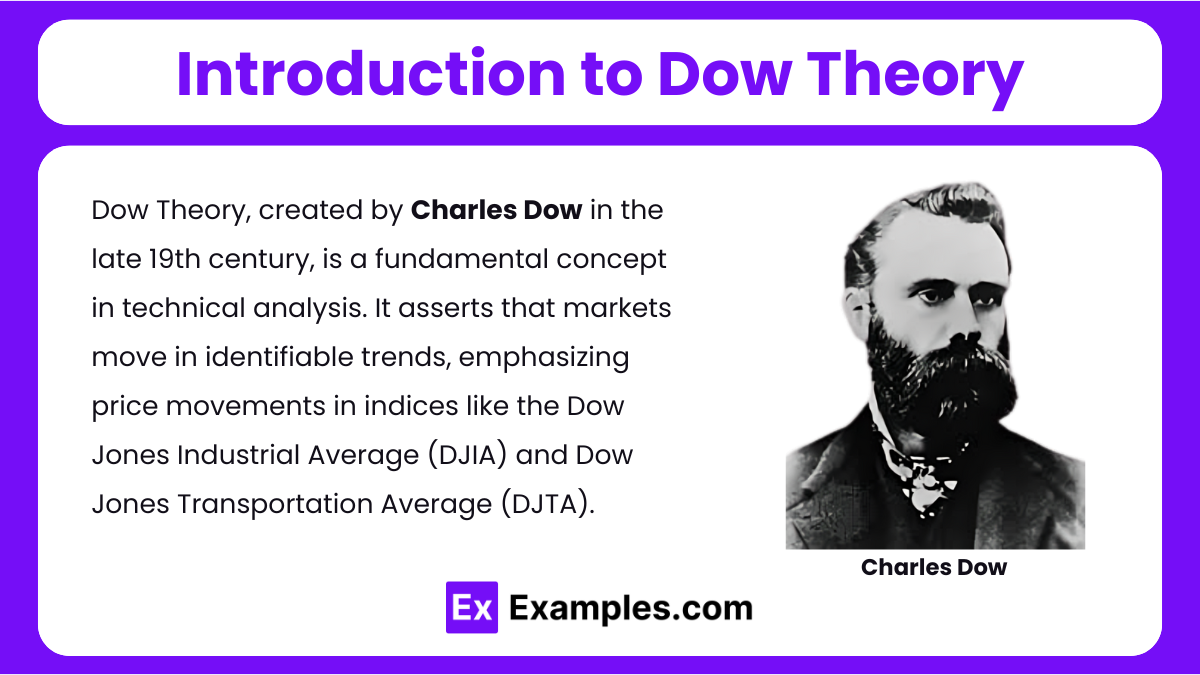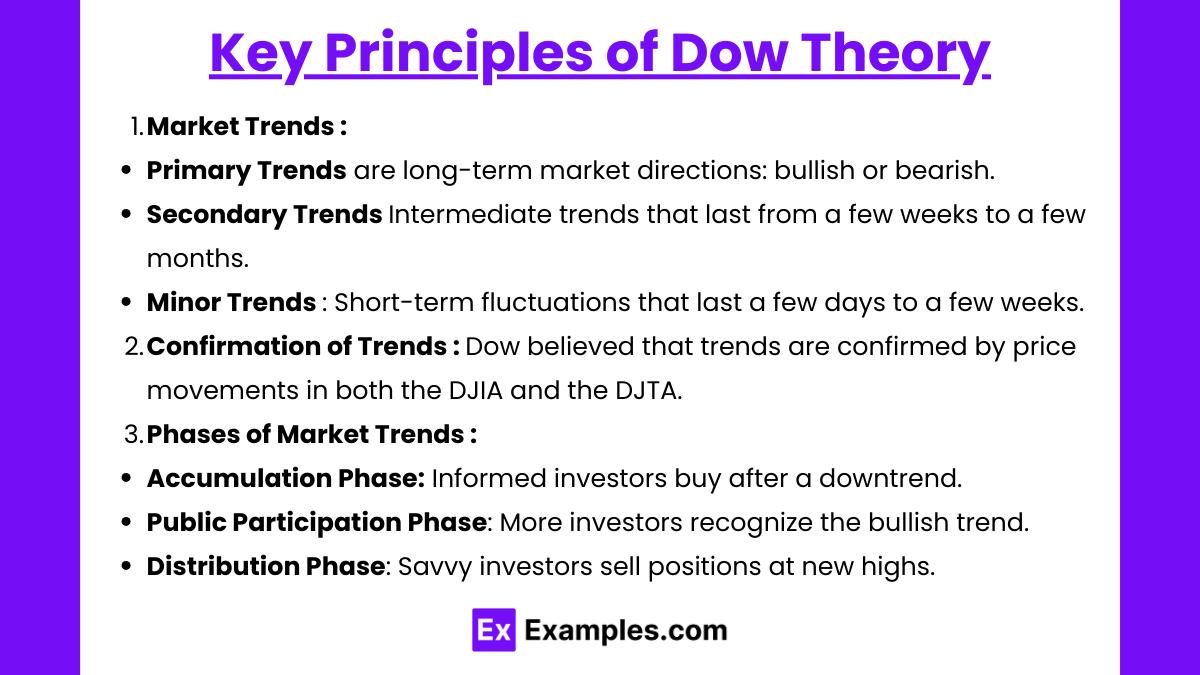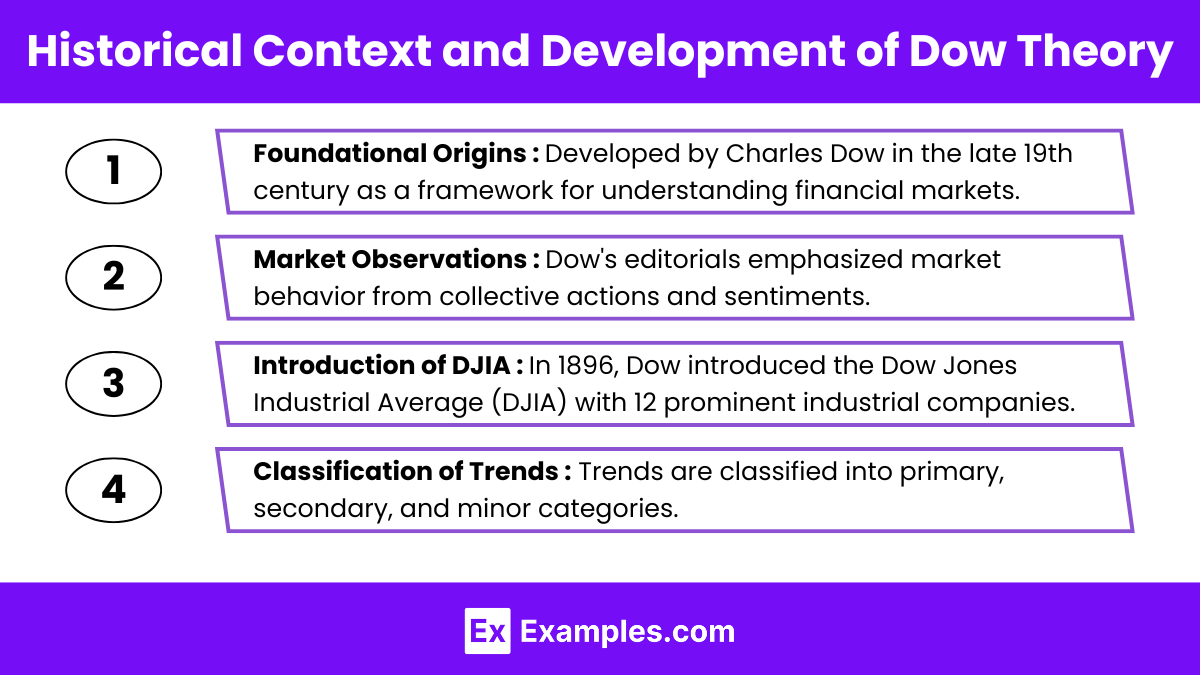The Dow Theory serves as a foundational principle in technical analysis, established by Charles Dow in the late 19th century. It emphasizes the importance of market trends and their role in guiding investment decisions. By categorizing trends into primary, secondary, and minor movements, Dow Theory provides a framework for understanding price behavior in financial markets. This theory advocates for the use of multiple indices, such as the Dow Jones Industrial Average and the Dow Jones Transportation Average, to confirm trends and gauge overall market sentiment, making it essential for traders and analysts alike.
Learning Objectives
In studying “Section I: Theory and History of Technical Analysis: Dow Theory” for the CMT Exam, you should learn to identify and understand the key principles of Dow Theory, including the concepts of primary, secondary, and minor trends. Analyze how these trends impact market behavior and trading strategies. Evaluate the significance of confirming trends through multiple indices, such as the DJIA and DJTA, and the role of volume in validating trends. Additionally, explore the historical context of Dow Theory’s development and its application in modern technical analysis, applying these insights to interpret market dynamics and enhance trading decisions
Introduction to Dow Theory

Dow Theory, developed by Charles Dow in the late 19th century, is a foundational concept in technical analysis that provides a framework for understanding market trends and movements. It is based on the idea that markets move in trends and that these trends can be identified and exploited for trading purposes. Dow Theory emphasizes the analysis of price movements in market indices, particularly the Dow Jones Industrial Average (DJIA) and the Dow Jones Transportation Average (DJTA).
Key Principles of Dow Theory

- Market Trends:
- Primary Trends: Long-term trends that can last from several months to years. Primary trends indicate the overall direction of the market—either bullish (upward) or bearish (downward).
- Secondary Trends: Intermediate trends that last from a few weeks to a few months. Secondary trends often act against the primary trend and can be seen as corrections or retracements.
- Minor Trends: Short-term fluctuations that last a few days to a few weeks. These trends are often noise within the larger context of primary and secondary trends.
- Confirmation of Trends:
- Dow believed that trends are confirmed by price movements in both the DJIA and the DJTA. For a primary uptrend to be confirmed, both indices should show higher highs and higher lows. Conversely, if one index is making new highs while the other fails to do so, it may indicate a weakening trend.
- Phases of Market Trends:
- Accumulation Phase: This phase occurs when informed investors begin buying securities after a downtrend. Prices may be relatively low, and market sentiment starts to shift.
- Public Participation Phase: During this phase, more investors become aware of the bullish trend, leading to increased buying pressure and higher prices.
- Distribution Phase: As prices reach new highs, savvy investors begin to sell off their positions, taking profits while the public is still optimistic. This phase often precedes a downturn.
- Volume as a Confirmatory Tool:
- Dow emphasized the importance of volume in confirming trends. Increasing volume during price advances supports the validity of an uptrend, while increasing volume during price declines supports a downtrend. A lack of volume may indicate a lack of conviction in the current trend.
- Market Discounts Everything:
- According to Dow Theory, all available information is reflected in the price of securities. This principle suggests that market prices adjust to new information, whether it’s economic data, earnings reports, or geopolitical events.
Historical Context and Development of Dow Theory

Charles Dow, co-founder of Dow Jones & Company, initially developed his theory through his editorial writings in “The Wall Street Journal.” His insights were based on the observation of market behavior and the collective actions of market participants. Dow Theory laid the groundwork for modern technical analysis, influencing various methodologies and trading strategies.
- Foundational Origins:
- Developed by Charles Dow in the late 19th century as a framework for understanding financial markets.
- Co-founder of Dow Jones & Company and editor of “The Wall Street Journal.”
- Market Observations:
- Dow published his theories through editorials that highlighted market behavior based on collective actions and sentiments.
- Argued that stock prices reflect broader economic conditions, marking a shift from traditional fundamental analysis.
- Introduction of DJIA:
- In 1896, Dow introduced the Dow Jones Industrial Average (DJIA) with 12 prominent industrial companies.
- Served as a benchmark for tracking stock market performance and gauging overall economic health.
- Classification of Trends:
- Identified three types of trends:
- Primary Trends: Long-term movements lasting several months to years.
- Secondary Trends: Shorter corrections within the primary trend, lasting weeks to months.
- Minor Trends: Short-term fluctuations lasting days to weeks.
- Identified three types of trends:
Application of Dow Theory in Trading

- Identifying Trends: Traders use Dow Theory to identify and confirm market trends, helping them decide when to enter or exit trades.
- Market Sentiment Analysis: By analyzing phases of market trends, traders can gauge market sentiment and adjust their strategies accordingly.
- Diversification Strategy: Dow’s emphasis on confirming trends through multiple indices encourages traders to consider the overall market picture rather than focusing on individual securities.
Examples
Example 1: Identifying Primary Trends
A trader analyzes the DJIA over a multi-year period and identifies a strong primary uptrend characterized by consistently higher highs and higher lows. The trader notes that significant economic indicators, such as GDP growth and low unemployment, support this bullish trend. By applying Dow Theory, the trader decides to take long positions on stocks that are part of the DJIA, anticipating that the primary trend will continue as market conditions remain favorable.
Example 2: Confirming Trends with Multiple Indices
An investor tracks both the DJIA and the DJTA, noticing that both indices have been making new highs simultaneously. According to Dow Theory, this confirms a strong primary uptrend in the market. The investor uses this confirmation to increase exposure to transportation and industrial stocks, believing that the alignment of both indices indicates robust economic activity and further price appreciation.
Example 3: Analyzing Secondary Trends
A technical analyst observes that the market has been in a primary uptrend but recently experienced a sharp decline in prices over a few weeks. This decline is identified as a secondary trend, representing a temporary correction within the overall uptrend. The analyst uses Fibonacci retracement levels to identify potential support levels where the price might stabilize before resuming its upward trajectory, allowing for strategic buying opportunities.
Example 4: Volume Analysis as Confirmation
A trader examines the volume accompanying price movements in a bullish market. According to Dow Theory, increasing volume during upward price movements strengthens the validity of the uptrend. The trader notes that volume has surged significantly on days when the market reaches new highs, leading them to confidently hold their long positions, believing that the trend is supported by strong market participation.
Example 5: The Accumulation Phase in Market Cycles
An investor recognizes the accumulation phase following a prolonged downtrend in a particular sector. During this phase, informed investors start buying securities at lower prices, anticipating a reversal in the primary trend. By applying Dow Theory principles, the investor watches for signs of upward price movement and increased volume, indicating that the accumulation phase is gaining traction. This strategic insight allows the investor to position themselves favorably before the broader market begins to recognize the potential for recovery.
Practice Questions
Question 1
Which of the following best describes a primary trend according to Dow Theory?
A) A trend that lasts for a few days to weeks
B) A long-term trend lasting several months to years
C) A trend that moves against the current market direction
D) A minor fluctuation within a secondary trend
Correct Answer: B) A long-term trend lasting several months to years
Explanation : In Dow Theory, a primary trend is defined as a long-term movement that lasts several months to years, indicating the overall direction of the market—either bullish or bearish. It reflects the general sentiment of investors over an extended period. In contrast, options A and D refer to minor and secondary trends, which do not represent the broader market direction. Option C is misleading because primary trends are not defined by their opposition to current market direction.
Question 2
According to Dow Theory, what is the significance of confirming trends with multiple indices?
A) It indicates that the market is moving irrationally.
B) It helps to identify potential price reversals.
C) It confirms the validity of a market trend.
D) It shows that volume is unimportant in trend analysis.
Answer: C) It confirms the validity of a market trend.
Explanation: Dow Theory emphasizes the importance of confirming trends through the analysis of multiple indices, such as the Dow Jones Industrial Average (DJIA) and the Dow Jones Transportation Average (DJTA). When both indices move in the same direction, it strengthens the credibility of the prevailing trend. This confirmation helps traders make informed decisions and reduces the likelihood of false signals. Option A is incorrect as it implies irrationality rather than analysis. Option B does not align with the confirmation aspect of Dow Theory. Option D is incorrect since volume is an important factor in confirming trends.
Question 3
What phase in Dow Theory occurs when informed investors start buying securities after a downtrend?
A) Distribution Phase
B) Public Participation Phase
C) Accumulation Phase
D) Secondary Phase
Answer: C) Accumulation Phase
Explanation : The accumulation phase in Dow Theory occurs after a prolonged downtrend when informed or savvy investors begin purchasing securities at lower prices, anticipating a future reversal of the primary trend. This phase marks the beginning of a potential bullish trend. Option A, the distribution phase, occurs at the end of a bullish trend when investors start selling off their positions. Option B refers to the phase where the broader public becomes involved in buying as the trend gains momentum. Option D is not a recognized phase in Dow Theory, as it does not accurately describe the process of accumulation.


